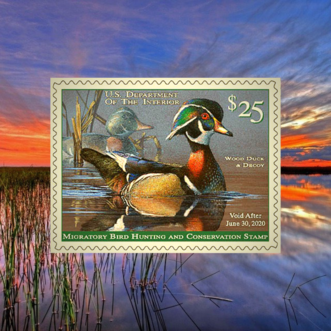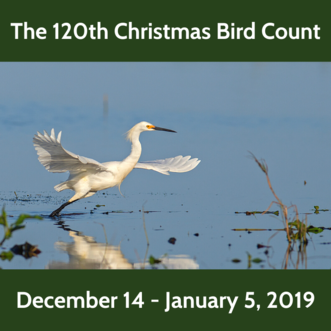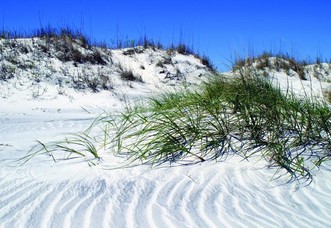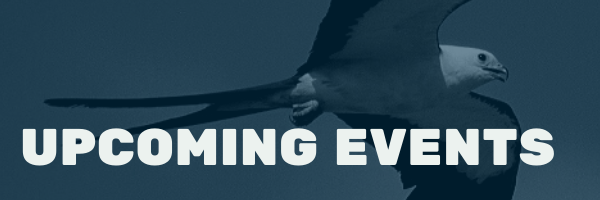 Purchasing a Duck Stamp is an easy way to support wetland conservation.
Florida’s wetlands are one of the most iconic parts of our natural landscape. Nearly a fifth of the total wetland area in the United States is found in the sunshine state. Not only do we have a lot of wetland habitat by area, but we have an incredible diversity of wetlands - here you can find coastal and freshwater marshes – including the 1.5 million acre expanse of the Everglades - seepage slopes, wet prairies, cypress domes, steepheads and mangrove swamps.
Wetlands also provide vital ecosystem functions. They are sometimes referred to as “nature’s kidneys” for their ability to filter excess sediment and nutrients from water, which can reduce the need for expensive water treatment centers. In fact, wetlands are so effective that water managers will often construct wetlands for the express purpose of water treatment. Wetlands also are effective at flood control, as they can act as sponges that will quickly absorb and slowly release surges of water.
Unfortunately, these crucial ecosystems are also highly threatened; exotic plants and animals, groundwater withdrawal, pollution, and development all pose very real threats. Florida has already lost more than half of its original wetland area. The good news? There are many programs in place to help protect these important places.
December 13 will mark the 30th anniversary of the enactment of the North American Wetlands Conservation Act (NAWCA). The act converted existing funds into a trust fund used to provide grants for wetland conservation. Here in Florida, NAWCA grants and partner contributions have provided more than $60 million to conserve and restore over 100,000 acres of wetland. Many popular sites on the Great Florida Birding and Wildlife Trail have benefited from the act, including Arthur R.Marshall Loxahatchee National Wildlife Refuge (NWR), Kissimmee Prairie Preserve State Park, and Biscayne National Park.
Another federal program that has been incredibly effective is the Duck Stamp. Purchasing a federal Duck Stamp is a simple action you can take to help protect our wetlands. You may be familiar with the Duck Stamp in the context of hunting, as all duck hunters are required to purchase them, but the stamps aren’t just for hunters – or just for ducks. 98% of the purchase price goes back into purchasing land or conservation easements for our National Wildlife Refuges, which benefit all wetland-dwelling birds and wildlife. Here in Florida, refuges such as St. Vincent NWR, J.N. Ding Darling NWR, and St. Marks NWR have all benefitted from funds raised from Duck Stamp sales. Beyond promoting conservation, your Duck Stamp will also get you free admission to any NWRs that charge an admission fee – a win-win for birds and the birders who love them. There are many places to purchase your stamp – many post offices and national wildlife refuges carry them, or you can buy online after logging into FWC’s Go Outdoors Florida page!
 2019 marks the 120th year of the Christmas Bird Count. Snowy Egret photo by Andy Wraithmell, FWC.
It’s that time of year again! The 120th Christmas Bird Count (CBC) is fast approaching. Since 1900, dedicated birders have devoted a day to censusing all the birds in their area. In its first year, 27 birders in 25 locations counted a total of 90 species; in the 2017-18 count, 76,987 participants in 2585 locations counted a whopping 2,673 species. The incredible dataset produced by generations of CBC participants has helped scientists reveal trends in bird populations that have significantly aided conservation efforts.
Are you interested in taking part this year? There are counts hosted across the U.S., Canada, the Caribbean, and Central and South America between December 14 and January 5. Find a count near you on our events page, on Audubon’s interactive CBC map or by reaching out to your local Audubon chapter. Many organizers will pair beginners with experienced birders, so this is an excellent way to hone your birding skills and meet new people if you are just getting started in the birding world.
The CBC is also a great way to finish out your 2019 Big Year strong, if your count is before the new year – if you participate in a January count, it is a wonderful way to start your 2020 list. Don’t forget to apply for your Wings Over Florida Big Year certificate and pin to celebrate your accomplishments!
 The Dune Ridge trail at Little Talbot Island State Park takes visitors through maritime forest and rolling dunes. Photo: FDEP
Earlier this month, we had the pleasure of exploring Big and Little Talbot Island State Parks in Jacksonville. With miles of undeveloped beaches, these parks are one of the last strongholds of pristine barrier island in northeast Florida – making them an incredibly important site for breeding shorebirds like Least Terns, Black Skimmers and American Oystercatchers.
The morning we set off for the parks was gray, windy, and drizzly, but we were still hopeful for a good day of birding as we geared up with our spotting scope, cozy sweatshirts and hot coffee. After dropping off some birding checklists at the ranger station on our way in (be sure to pick one up when you visit!), we took off north on A1A to Spoonbill Pond. While we didn’t see any of the pond’s namesake Roseate Spoonbills, a stroll down to the boat ramp and along the boardwalk gave us great views of Wood Storks, Tricolored Herons, Killdeer and Dunlin. Closely scouting the edge of the parking lot, we were rewarded with Clapper Rails calling from the marsh and an Indigo Bunting devouring seeds near the ground.
In addition to wonderful birding opportunities, the parks offer several miles of hiking and biking trails, comfortable modern campsites, and opportunities for paddling, surfing and fishing.
On our way back to Jacksonville, we made what we thought would be a relatively quick stop at Huguenot Memorial Park. On the drive down to the shore, we picked up Loggerhead Shrikes, Savannah Sparrows and Osprey soaring overhead. When we came to the water, we watched some Ruddy Turnstones and Semipalmated Plovers foraging as they dodged the strong surf. A few gulls soaring on the other side of the jetty kept us moving down the beach, and we were not prepared for what was on the other side – hundreds of birds were hunkered down on the lee side. A quick scan with the scope yielded Great and Lesser Black-backed Gulls, Caspian, Royal, and Sandwich Terns, and more – well worth having to bundle up on a cold, damp day.
 November 30 – Camp Helen Monthly Bird Survey (Panama City Beach)
November 30 – Coehadjoe Park Nature Walk (Ocala)
November 30 – Cruickshank Sanctuary Field Trip (Rockledge)
December 1 – Bird Walk for Beginners at Fort Caroline (Jacksonville)
December 2 – Birding Lake Jesup Conservation Area (Sanford)
December 6 – Chips, Chirps, and Cheer – Space Coast Audubon Holiday Social (Rockledge)
December 7 – Brooksville Wetlands Fieldtrip (Brooksville)
December 7 – 6th Annual Christmas Bird Count for Kids (Green Cove Springs)
December 8 – Field Trip: Little Talbot Island State Park (Jacksonville)
December 8 – I’ve Got an App for That Bird (Classroom Instruction & Hands-on Practice) (Satellite Coast)
December 8 – Butterflies and the Plants They Need (Sanford)
December 10 – Birds and Brunch (Panama City)
December 11 – Tram Tour at Orlando Wetlands Park (Christmas)
December 11 – Fort King Nature Walk (Ocala)
December 11 – Night Walk at Lake Woodruff NWR (DeLeon Springs)
Check out the events page of our website for more events across the state!
Do you know about any other bird- or wildlife-related events going on in Florida? Help spread the word by letting us know! Send in the times, dates, locations and contacts to wildlifeviewing@myfwc.com for posting on the Great Florida Birding and Wildlife Trail website.
Events must be related to birds or other wildlife and must be open to the public. Examples include interpretive programming, summer camps and family programs.
|